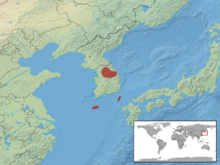| Scincella vandenburghi | |
|---|---|

| |
|
Scientific classification
| |
| Domain: | Eukaryota |
| Kingdom: | Animalia |
| Phylum: | Chordata |
| Class: | Reptilia |
| Order: | Squamata |
| Family: | Scincidae |
| Genus: | Scincella |
| Species: | S. vandenburghi
|
| Binomial name | |
| Scincella vandenburghi (
Schmidt, 1927)
| |

| |
| Synonyms [2] | |
| |
Scincella vandenburghi, also known commonly as the Korean skink, the Tsushima ground skink, and the Tsushima smooth skink, is a species of skink, a lizard in the family Scincidae. The species is endemic to East Asia
S. vandenburghi is found on the Korean peninsula and on Tsushima Island, Japan. [2]
Scincella vandenburghi may be a synonym of Scincella modesta. [1] [2]
S. vandenburghi is named after John Van Denburgh, curator of herpetology at the California Academy of Sciences. [2] [3]
S. vandenburghi inhabits temperate forests where it can be found on the forest floor. [1]
S. vandenburghi is oviparous, laying one to nine eggs in early summer. [1]
- ^ a b c d Shin, Y.; Kidera, N.; Ota, H. (2021). "Scincella vandenburghi". IUCN Red List of Threatened Species. 2021: e.T178539A96878281. doi: 10.2305/IUCN.UK.2021-2.RLTS.T178539A96878281.en. Retrieved 20 November 2021.
- ^ a b c d Scincella vandenburghi at the Reptarium.cz Reptile Database. Accessed 24 October 2014.
- ^ Beolens, Bo; Watkins, Michael; Grayson, Michael (2011). The Eponym Dictionary of Reptiles. Baltimore: Johns Hopkins University Press. xiii + 296 pp. ISBN 978-1-4214-0135-5. (Scincella vandenburghi, p. 271).
- Park J, Koo K-S, Kim I-H, Park D (2016). "Complete mitochondrial genomes of Scincella vandenburghi and S. huanrenensis (Squamata: Scincidae)". Mitochondrial DNA Part B Resources 1 (1): 237–238.
- Schmidt KP (1927). "Notes on Chinese Reptiles". Bull. American Mus. Nat. Hist. 54 (4): 467–551. (Leiolopisma vandenburghi, new species, p. 501).
| Scincella vandenburghi | |
|---|---|

| |
|
Scientific classification
| |
| Domain: | Eukaryota |
| Kingdom: | Animalia |
| Phylum: | Chordata |
| Class: | Reptilia |
| Order: | Squamata |
| Family: | Scincidae |
| Genus: | Scincella |
| Species: | S. vandenburghi
|
| Binomial name | |
| Scincella vandenburghi (
Schmidt, 1927)
| |

| |
| Synonyms [2] | |
| |
Scincella vandenburghi, also known commonly as the Korean skink, the Tsushima ground skink, and the Tsushima smooth skink, is a species of skink, a lizard in the family Scincidae. The species is endemic to East Asia
S. vandenburghi is found on the Korean peninsula and on Tsushima Island, Japan. [2]
Scincella vandenburghi may be a synonym of Scincella modesta. [1] [2]
S. vandenburghi is named after John Van Denburgh, curator of herpetology at the California Academy of Sciences. [2] [3]
S. vandenburghi inhabits temperate forests where it can be found on the forest floor. [1]
S. vandenburghi is oviparous, laying one to nine eggs in early summer. [1]
- ^ a b c d Shin, Y.; Kidera, N.; Ota, H. (2021). "Scincella vandenburghi". IUCN Red List of Threatened Species. 2021: e.T178539A96878281. doi: 10.2305/IUCN.UK.2021-2.RLTS.T178539A96878281.en. Retrieved 20 November 2021.
- ^ a b c d Scincella vandenburghi at the Reptarium.cz Reptile Database. Accessed 24 October 2014.
- ^ Beolens, Bo; Watkins, Michael; Grayson, Michael (2011). The Eponym Dictionary of Reptiles. Baltimore: Johns Hopkins University Press. xiii + 296 pp. ISBN 978-1-4214-0135-5. (Scincella vandenburghi, p. 271).
- Park J, Koo K-S, Kim I-H, Park D (2016). "Complete mitochondrial genomes of Scincella vandenburghi and S. huanrenensis (Squamata: Scincidae)". Mitochondrial DNA Part B Resources 1 (1): 237–238.
- Schmidt KP (1927). "Notes on Chinese Reptiles". Bull. American Mus. Nat. Hist. 54 (4): 467–551. (Leiolopisma vandenburghi, new species, p. 501).
